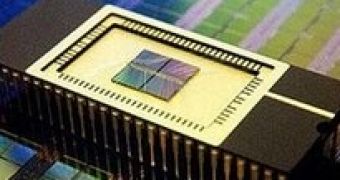Intel looks really interested in memory technologies that could replace NAND based flash memory in the near future. It is rumored that Intel will set up a joint venture with Numonyx for the development of a technology that would allow phase change memory to be produced at an industrial scale. Numonyx is the spin off company formed by the ex Intel flash memory division in cooperation with the ST Microelectronics European firm and it is currently focusing on the development of new non volatile memories.
The collaboration between Intel and ST Microelectronics goes back to 2003 and from it resulted the 128MB Alverstone flash chip based on phase change memory and the new research and development effort is aimed at converting a prototype to a product ready for the end market. For phase change memory to successfully replace the NAND based chips on the non volatile memory market, a number of improvements must be made over the currently used standard. Until now, researchers from Intel and Numonyx improved the maximum number of write cycles that can be performed on the flash chip, raising the number from one million to over 100 million. Other areas marked for improvements are data transfer rate and memory responsiveness. According to Intel, cited by the news site TGDaily, PCM memory chips could be used as the base circuits of SSDs, solid state drives, that are faster at some operations that traditional platter based hard disk drives. Intel hopes that PCM memories that would be integrated in SSDs will prove to be fast enough in order to prevent "multi-core CPU-based systems from choking on I/O limitations."
The phase change memory is called non volatile as it is able to store an information for extended periods of time without being powered. Currently used flash memory chips are using a silicon or silicon nitride gate to store an electric charge, while PCM goes for a chalcogenide-based technology which is very similar to the technology used in rewritable CDs. Heat provided by a small laser transforms the chalcogenide alloy from a crystalline (conductive) form to an amorphous state that is electrical-resistive.
PCM memory is not without its own drawbacks as it is believed to be very sensitive to temperature changes, but despite being a yet immature technology, it already reached impressive data storage densities, and it may become the successor of the flash memory.

 14 DAY TRIAL //
14 DAY TRIAL //